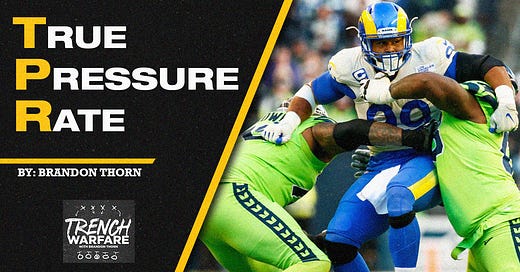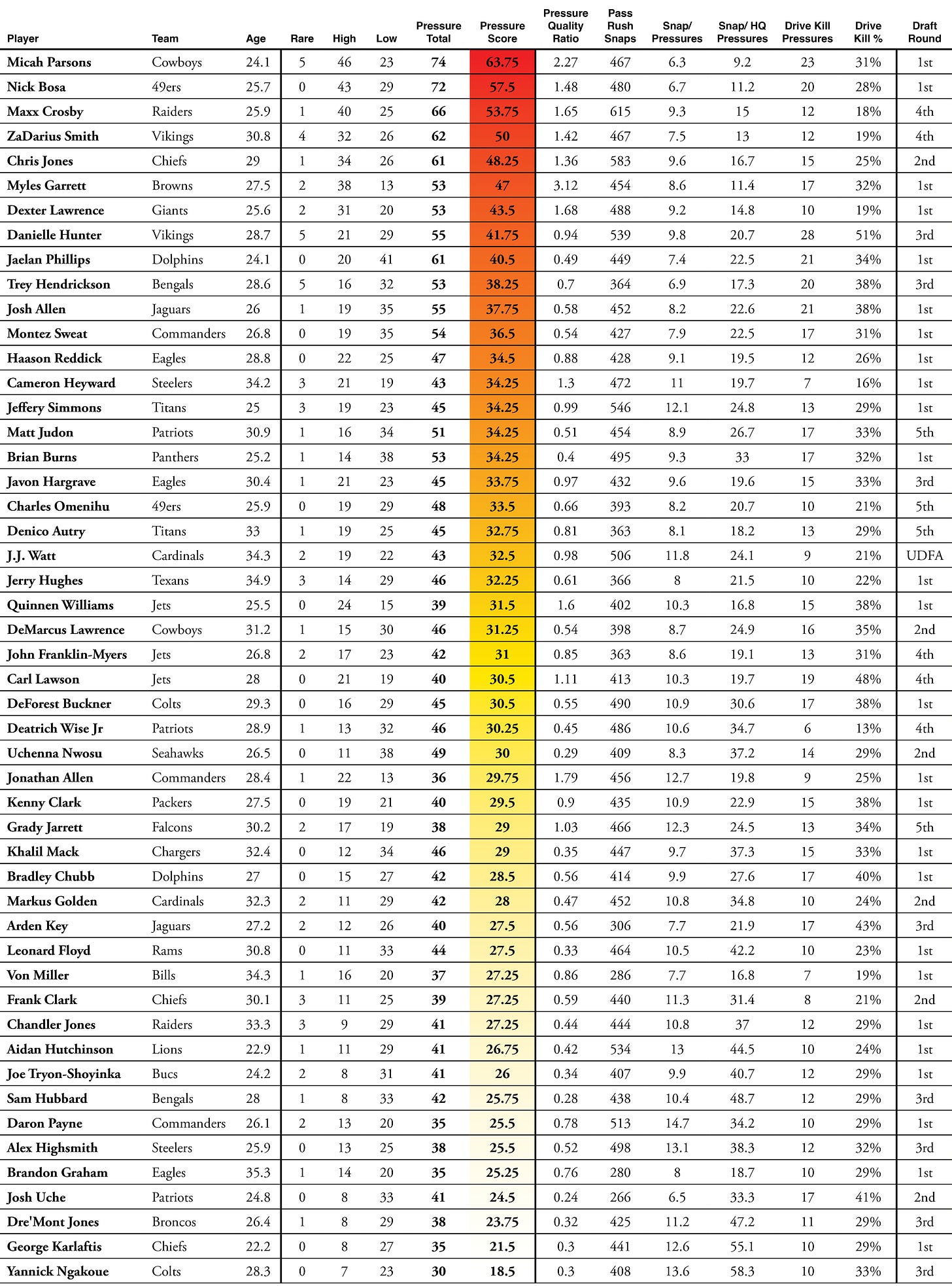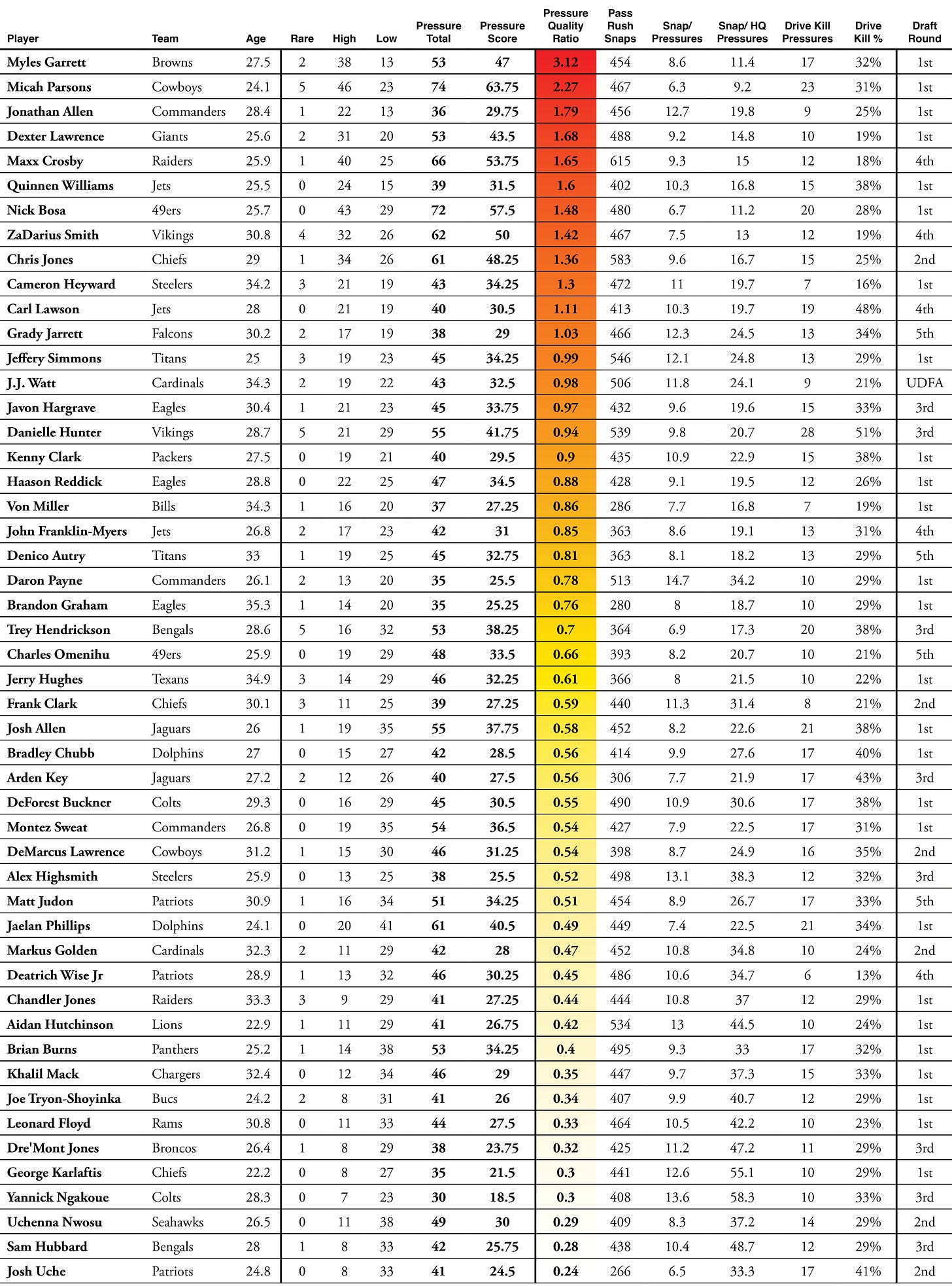Over the past three seasons of the True Sack Rate (TSR) I’ve paid homage with the cover photo of those articles to some of the top sack artists of all-time: Reggie White (2020), Bruce Smith (2021) and Julius Peppers (2022). For the first year of the True Pressure Rate (TPR) I wanted to use the player with more pressures than any pass-rusher in the NFL since 2017, Rams DT Aaron Donald.
Introduction
Welcome everyone to the first edition of the True Pressure Rate (TPR), a complementary evaluation tool to pair with the TSR to bring much-needed context to the ‘sack’ and ‘pressure’ statistics while simultaneously providing a more refined gauge on determining who actually are the most skilled, impactful and valuable pass-rushers in football.
From a team perspective, all pressures are positive for a defense, but they can mean very different things for an individual pass-rusher making the play. Player evaluation based on raw pressures often paints an incomplete picture.
A pressure is compiled by most companies (including PFF) as the sum of QB hits/knockdowns, hurries and sacks. Sacks are self-explanatory (tackling the QB at or behind the line of scrimmage), but what are QB hits/knockdowns and hurries?
Per PFF, a QB hurry is defined as, “Forcing a quick throw, flushing the quarterback from the pocket, forcing the quarterback to step up in the pocket, forcing the quarterback to throw a pass away, preventing a quarterback from stepping up into the pocket by collapsing the pocket or preventing the quarterback from stepping into the throw. In the event of the quarterback being forced to step up, the pass rusher absolutely must have beaten the blocker and be past the blocker’s shoulder to be credited with a pressure. If the blocker clearly pushes the defender deep and past the depth of the quarterback’s drop back, then this is not a QB pressure. Multiple defensive players can be credited with a hurry on a given pass play.”
A QB hit is defined as, “Recorded after or as the quarterback releases the pass and a defender hits the quarterback such that the quarterback goes to ground. The quarterback must go down as an action of the defender. Multiple defensive players can be credited with a hit on a given pass play.”
While these definitions sound extremely detailed and theoretically add more nuance and context than sacks do, there is still a grey area.
Take this example from 49ers edge-rusher Nick Bosa from Week 17 of the 2022 season against the Raiders. Bosa was credited with ten QB pressures on the day, but studying each one revealed that number is void of much-needed context.
Here are five of Bosa’s 10 pressures in question. These are simply recorded as ‘pressures’ by PFF, but for the TPR they were recorded as ‘low-quality’ or ‘unblocked’ pressures.
Rep 1 - Low quality pressure: Raiders LT Kolton Miller anchors on Bosa, yet Bosa is still credited with a pressure due to the QB escaping in his direction due to opposite side pressure that collapsed the pocket, forcing the QB to run in his direction.
Rep 2 - Low quality pressure: Bosa’s attempted inside swipe is thwarted by Miller. The QB has to run towards Bosa due to an unblocked blitzer off of the opposite side, creating an opportunity for Bosa to notch a QB hit. Bosa should get some kudos for staying active and using an outside spin to work off of being shut down going inside, but opposite side pressure is the primary reason he was in position to notch a QB hit.
Rep 3 - Unblocked pressure. This one is self-explanatory. Nothing of note was done here from Bosa other than fill space towards the QB.
Rep 4 - Low quality pressure: At first glance Bosa does work past the pulling left guard towards the QB, but the opposite side 3-technique works free through the center of the pocket to force the QB off of his spot, out of the back of the pocket and into Bosa’s path. This is a good example of ‘fortunate circumstances.’
Rep 5 - Unblocked pressure: Bosa gets the QB hit as the unblocked looper on a three-man twist/game. This is a schematic win for the 49ers pass-rush with Bosa merely executing his assignment without demonstrating any special skill or trait.
Now contrast those five LQ pressures with Bosa’s other five pressures, all of which I charted as HQ:
By differentiating and qualifying these different pathways to notching a pressure into three different categories — using film study, charting, and a simple grading scale — we gain valuable insight into which players are earning their production vs. which players are the beneficiaries of fortunate circumstances (like sacks, you’d be surprised just how many ‘pressures’ are the result of fortunate circumstances).
Through this process and combining the results with the TSR, we will be able to more accurately evaluate pressure, sack and overall pass-rush production for the defensive line.
The TPR will provide us with each rusher’s “pressure score,” based on a point system that specifies three different types of pressures, as outlined below:
1.25 points: Rare High Quality (RHQ) Pressure - A 1-on-1 QB hit or hurry over a very good (Ex: Andrew Thomas) or elite (Ex: Trent Williams) blocker due to the rusher’s skill, move(s) and/or athletic ability.
Example: (2022) Cowboys edge-rusher Micah Parsons beating Bucs RT Tristan Wirfs 1v1 with an inside club move for a pressure.
1.0 point: High Quality (HQ) Pressure – A 1-on-1 (or 1-on-2) QB hit or hurry against an above (or below) average blocker due to the rusher’s skill, move(s) and/or athletic ability.
Example (2022): Browns DE Myles Garrett using an inside stab-bull to win 1v1 vs. Ravens RT Morgan Moses.
.5 points: Low Quality (LQ) or Unblocked Pressure – A pressure coming as a result of the QB running into the rusher’s direction due to scheme (bootleg, roll-out), pressure from another rusher or being unblocked due to scheme (stunt, twist) or a missed assignment.
Example (2022): Raiders edge-rusher Maxx Crosby getting an unblocked pressure as the looper on a T-E stunt primarily due to the RG being late to pick him up, opening the door for a clear path to the QB.
Before we get into the results here are a few notes:
All stats are via TruMedia and PFF
2313 pressures from 50 players were charted and graded
Sacks are typically counted in the QB hit category and also into the pressure total for players via TruMedia, but I omitted sacks from these numbers since I already charted/graded those separately for the TSR project. To clarify, the TPR only consists of QB hits/knockdowns (minus sacks) and QB hurries.
While the Pressure Score accounts for quality, it's heavily affected by volume, so I am introducing another metric called the Pressure Quality Ratio (PQR) that shows the ratio of Rare High Quality + High Quality pressures to Low Quality pressures. While volume is certainly valuable, this helps show why two players with similar total pressures are scored differently, or can help you identify players that may have a lower total volume but are essentially "working harder" for that lower volume. "Working harder" could be due to scheme, attention from offensive personnel, quality of opposing player, etc. In other words, the combination of the pressure score and the pressure quality ratio can level the playing field between players in disparate circumstances. I'd pay attention particularly to outliers in Pressure Quality Ratio.
2022 Results
*All graphics made by John Pulice.
Top 50 in pressure score:
RHQ pressures (1.5 points) + HQ pressures (1 point) + LQ pressures (.5 point)
Micah Parsons, Nick Bosa and Maxx Crosby came in first-second-third in pressure score, which is no surprise. Those three were also 1-2-3 in total pressures with more volume than everyone else, plenty of HQ pressures and all with a pressure quality ratio of 1.48 or higher (more on the significance of this soon).
The next two on the list both rank fourth and fifth in total pressures (Chris Jones and Za’Darius Smith) as well as pressure score. Each of their PQR’s were 1.30 or above, signaling an elite rate of HQ pressures along with volume. These were the five most productive pass-rushers in football last season based purely on QB hits and hurries.
Next on the list is Myles Garrett, who ranks 10th in total pressures, but 6th in pressure score. This was thanks to a ridiculously high degree of HQ pressures compared to LQ and a staggering PQR of 3.12 (more on this below).
After Garrett is Dexter Lawrence, the second most productive defensive tackle in football last season behind Jones. Lawrence was tied for tenth with Garrett in total pressures, but came in seventh in pressure score with a PQR of 1.68, good for fourth overall and second among DTs behind Jonathan Allen.
Lawrence had a season for the ages in 2022 considering he is a 340 pound nose tackle, who operates in tighter quarters often with more bodies to navigate through/around then a 3-technique.
Jaelan Phillips was tied for fifth in total pressures with Jones yet ranked ninth in pressure score due to a relatively low amount of HQ pressures with 20, which ranked 18th overall. Phillips had a very good year in terms of volume of pressures, but upon further inspection, the Dolphins scheme did heavy lifting for his production, often opening up lanes to the QB on stunts, twists and overloaded fronts.
Brian Burns ranked 17th in pressure score primarily due to volume (tied for tenth in total pressures), but had a PQR of .40 with only 15 HQ pressures out of 53. Burns was also a beneficiary of scheme freeing him up for a lot of easy pressures. His red-hot motor helped him routinely capitalize on slow processing QBs.
Nine pass-rushers had at least three or more rare HQ pressures:
5 - Micah Parsons, Trey Hendrickson and Danielle Hunter
4 - Za’Darius Smith
3 - Jeffery Simmons, Cameron Heyward, Jerry Hughes, Chandler Jones and Frank Clark
Of the top 50 in pressure score, 27 players were first-round picks, six were second-round picks and eight were third-round picks (41 total). That leaves just nine of the top 50 as day three or later picks with one former undrafted free agent in Denico Autry.
Top 50 in pressure quality ratio (PQR):
RHQ pressures + HQ pressures / LQ pressures
This metric measures the most high-octane, impactful rushers on a snap-to-snap basis, and Myles Garrett is head and shoulders above the rest of the league with a staggering PQR of 3.12. Garrett had 53 total pressures in 2022, but 40(!) of them were HQ. For comparison, Brian Burns also had 53 pressures last season with 15 of them being HQ. Since the 2020 season when I started charting every sack by a defensive lineman, Garrett leads the NFL in sack score by a comfortable margin. Now, in my first iteration of the TPR, he separates himself even more from his peers in terms of the level of skill on display and overall impact as a pass-rusher.
If not for Garrett’s absurd PQR, Parsons would be hands down the most impactful pass-rusher from the 2022 season. Parsons’ PQR of 2.27 is the only score of ‘2’ or higher in the NFL aside from Garrett. The former Penn State linebacker led the NFL in total pressures, pressure score, fewest snaps per pressure and fewest snaps per HQ pressure. Parsons also finished fourth in sack score. In just his second season, Parsons has cemented himself as a top three edge-rusher in football with the runway at 24 years old to get even better.
A score of 1.00 or better in the PQR signals a rusher that was on an absolute heater during the season. That means that at least every other pressure was on average HQ. 12 total pass-rushers made up of six edge-rushers and six defensive tackles finished with a PQR of 1.00 or better.
Speaking of defensive tackles, Jonathan Allen led the NFL in PQR for his position followed closely by Dexter Lawrence and Quinnen Williams. Chris Jones, Cameron Heyward and Grady Jarrett were next.
Jeffery Simmons, J.J. Watt, Javon Hargrave and Kenny Clark didn’t hit the 1.00 mark in PQR, but were all between .99-.90, a stellar rate of HQ to LQ pressures.
On the other end, the least impactful pass-rushers in terms of the ratio of HQ to LQ pressures were Josh Uche, Sam Hubbard, Uchenna Nwosu, George Karlaftis, Yannick Ngakoue, Dre’Mont Jones and Leonard Floyd. Despite the middling production in terms of pressure quality, Uche ranked 14th in sack score with most of his impactful rushes coming in the sack department rather than finishing in just pressures. The same was true for Ngakoue (23rd in sack score) and Nwosu (26th in sack score).
Keep reading with a 7-day free trial
Subscribe to Trench Warfare to keep reading this post and get 7 days of free access to the full post archives.






